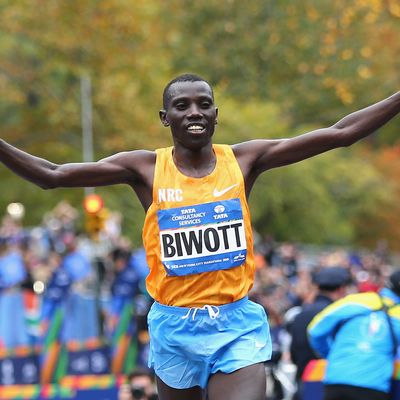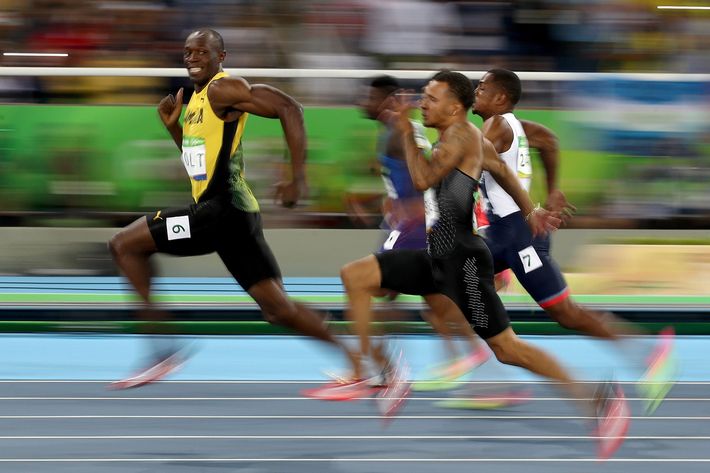
So, this weekend, you’re going to be one of the 50,000 people running the New York City Marathon, the world’s largest. It’s your first race; You’re surrounded by thousands of people; your friends are cheering you on; and you feel like you’re going to explode with excitement. The starting cannon fires; Frank Sinatra’s “New York, New York” starts playing. You’re as fired up as you’ve ever been, so you run your fastest, right? Well, according to loads of data, you shouldn’t, at least not at first. Counterintuitive as it might seem, the key to performance in endurance sports is, in a real way, keeping yourself chill, even as your muscles burn with intensity.
University College Dublin computer scientist Barry Smyth, who authors the Running With Data blog, has found that marathoners’ folk wisdom of starting slow is backed up by the data. As highlighted on Quartz, Smyth’s analysis of the Dublin Marathon — 100,000 or so runners, from 2000 to 2015 — found that when a runner’s fastest leg came in the first third of the race, they averaged a finish that was 40 minutes after people who had taken their time in the first chunk, as illustrated in the below chart.
Similarly, crunching Chicago Marathon data from 2005 to 2016, of over 400,000 runners, revealed that if your fastest five kilometers were the first five kilometers — the case for about 40 percent of runners — you ran a slower race and were more likely to “hit the wall,” where your legs turn to jelly and you’re forced to slow down dramatically.
“The data has proved to me that running an evenly paced race — that is, maintaining the same pace throughout or as near to it as the terrain will allow — is your best bet for an optimal race,” Smyth told Science of Us in an email. “My instinct is that being mindful of your race and your pacing and being relaxed in your form is likely to promote a more controlled and disciplined race with more even pacing throughout.”
This is a theme that came up repeatedly with sports scientists and endurance athletic coaches: that doing your best half-marathon, triathlon, or 5K depends on being able to relax within the physical intensity you’re putting yourself through — not only for running, but cycling and swimming as well. It clicked into focus for running coach Danny Dreyer — author of ChiRunning: A Revolutionary Approach to Effortless, Injury-Free Running and finisher of 43 ultramarathons and counting — when he was teaching NASA rocket scientists in the Bay Area in 1999. Since his running technique is based on tai chi principles, he expected to be greeted with lots of skepticism, but as his students informed him, the way relaxation breeds efficiency becomes obvious if you look at it from an engineering perspective.
“If you have any part of a machine not doing its full job, it’s creating inertia for the rest of the machine,” he says. “Better performance is really based on economy of motion. If you’re inefficient in how you move, your performance isn’t going to be as good. So you need to work on your efficiency of performance, and where do you hold tension where you need to be. It’s going to give you less of a range of motion, other muscles will have to work harder.” Consider a bicep: If it’s going to fire fully, it needs the tricep to relax. In anatomical terms, they’re antagonist and agonist, as many muscles are. They do their best work when one allows the space for the other, like an elite tag team. The point is not lack of effort, but lack of tension. Then your exertion, as extreme as it might be, can be more joyous than punitive. “You can be the strongest runner in the world, but if you’re running inefficiently, you might perform well, but it doesn’t feel good,” Dreyer says. “People who win the race and collapse, versus win the race with a smile like the Kenyans do.”
The principal becomes even more obvious in the water. Terry Laughlin, the inventor of Total Immersion Swimming, says that he had a breakthrough when he moved from coaching people who had grown up in the pool to “adult-onset swimmers,” who took up swimming later in life, to prepare for a triathlon or master a new skill or find a low-impact aerobic activity. “I think there’s something unique about swimming: We are terrestrial mammals, land dwellers, and swimming is aquatic,” he says, and you can see in it how woeful humans are in terms of efficiency. The Pentagon’s research wing has found that humans convert about 3 percent of their kicks and strokes into forward energy, compared with dolphins, who get 80 percent forward motion with every thrust. To become a stronger swimmer, then, is to become more efficient — and take after our warmblooded, ocean-dwelling mammalian peers.
For the more terrestrial among us, swimming feels like an exercise in survival, Laughlin says, because that’s the only swimming experience people have had. Because of that, it’s easy to spend a lot of time fighting ourselves and fighting the water, trusting the protestant work ethic guarantee that the more we struggle against life, the better we’ll do. But if you stop panicking and start attending to your experience, then the relaxation and efficiency can increase. “Do you see a lot of bubbles?” Laughlin likes to ask. “Is your stroke noisy and splashy? Can you swim more quietly?”
Part of the reason the greats “make it look easy” is because they embody a certain chill excellence. Mayo Clinic sports scientist Michael Joyner points to Michael Phelps in the Rio Summer Olympics 4x100 relay, who executed “the best turn ever” in his leg of the race. Phelps pushed off the wall and stayed underwater, executing “dolphin kicks” that propelled the U.S. toward gold. Deadspin’s Timothy Burke noted that Phelps finally surfaced an “astonishing 2.5 seconds after the Frenchman who touched the wall in the lead.” Staying underwater means that the swimmer faces far less resistance than on the surface, the research indicates. But swimming underwater also requires feeling at home — a sense of effort, command, mastery, and relaxation within the water. “He was able to absolutely nail this turn,” Joyner says. “Other swimmers [were] in a hurry to get to the surface and stroking, and Phelps takes his time with dolphin kicks.”
Phelps’s most direct terrestrial peer, Usain Bolt, is another study in relaxed excellence. To Dryer, Bolt’s trademark chillness — boogying before race starts, grinning his way into memedom before it ends — is part of why he’s so dominant, in addition to his six-foot-five-inch height, and a longer stride than most any other sprinter. “A fast runner has a longer stride length than a slow runner,” Dreyer says. “If there’s tension in any muscles junctures, that will reduce your range of motion and reduce your speed. If your muscles are relaxed, all those tendons and ligaments get to go their full length, and their stride really opens up. Usain Bolt is giant in every aspect, he has such range of motion. He doesn’t have to turn his legs over as fast. He’s not working as hard as people who don’t have the same-length legs as him.” So Bolt gets through 100 meters in 41 strides, with more mortal sprinters averaging 45 strides. As well, the research indicates, he fatigues more slowly than everyone else.

Bolt’s grin also speaks to how finding enjoyment in the physical intensity is so helpful to performance: Joyner, the sports scientist, says to interpret the burning sensation that you get in your muscles not as pain, but as a signal that you’re at your “redline”: pushing yourself but still in control, like a car engine being pushed to its max. (Relatedly, therapies that train people to engage with discomfort, rather than shrink from it, have been shown to be super effective in getting people who don’t work out to start doing so.) The problem with worrying about your competition, which is understandable if you’re going against your local Bolt or Phelps, is that your mind “starts chattering,” says Dreyer. In a very practical sense, anxiety’s linguistic narratives distract your attention from the task at hand. That’s why Golden State Warriors coach Steve Kerr and Seattle Seahawks skipper Pete Carroll both venerate a quirky little book called The Inner Game of Tennis: The Classic Guide to the Mental Side of Peak Performance: Rather than berating yourself for missing the last shot or being further behind than you thought, the book advises, invest that mental energy into attending to your felt awareness.
With that comes a sense crucial to both yogis and athletes: proprioception, or your felt sense of where your body is in space. To actually relax within the intensity — and also prevent injury — it’s crucial to be moving with the proper alignment. If you’re feeling tension somewhere, don’t fight it; address it, and make adjustments. When I talked to Dreyer for this interview several weeks ago, I told him about my tendency toward supination, where the outside toes support an outsize amount of the stride. His advice: Train in always running with your feet in the direction you’re headed, otherwise there’s risk of ankle injuries and stress fractures in those tiny little foot bones. By keeping the feet pointed forward, the abductor muscle is strengthened and the leg is held in a straight line, and the whole foot takes on the force. It’s like many hands make small work, but inside the foot. The point, he says, is to listen to the communication of your body: Rather than getting an Advil when your foot is sore, make adjustments, and train yourself into greater balance and efficiency. “When you’re walking around the office, roll over your entire foot,” he says. “‘I’m rolling over all five toes!’ – that’s your mantra.” Of course, you’re not going to be able to take a yogi’s perspective on your 5K if you’re going at full speed, which is why it’s important to incorporate slower, more technique-oriented workouts into your weekly flow.
The key, really, is to use the resources available to a runner – gravity and traction. Dreyer says that you shouldn’t be using your legs for propulsion. Properly harnessed, gravity will pull you forward, while your core will stabilize you, and your legs will keep balanced. He thinks of it as two “circles of motion,” where everything above your waist is going forward and everything below goes backward. Your feet should be light and stable, pointed in the direction of travel. “Whenever I’m doing tai chi, I want to move with whatever forces are at work,” he says. “If I’m moving in the same direction as a punch, that zeroes it out. With running, the two forces are gravity and the road. You want the legs to move with the road. The more you allow your body to cooperate with the pull of gravity, the more efficient you’ll be, the more you can relax, and that increases your performance.”

